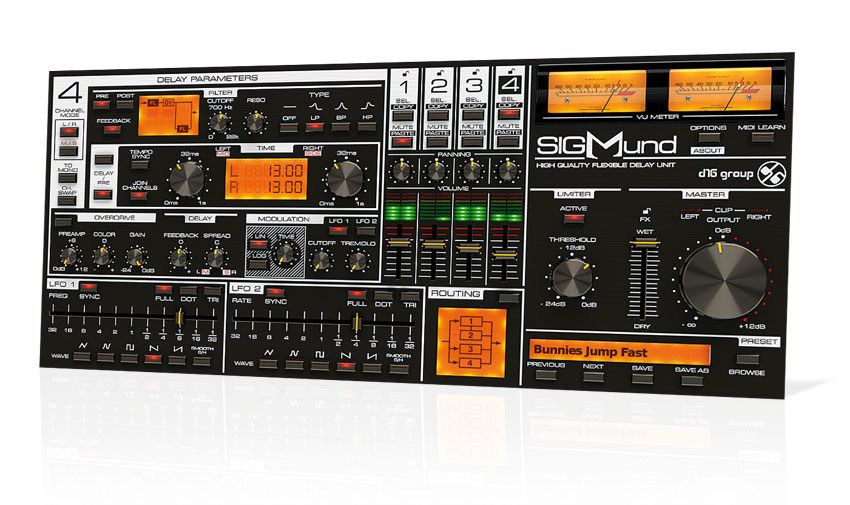MusicRadar Verdict
Perhaps a new benchmark for delays, Sigmund offers a broad range of effects, sounds brilliant and is easy to use.
Pros
- +
Versatile. Beautiful sound. Great presets. Powerful routing. Clear interface. Awesome stereo manipulation tool.
Cons
- -
Can be taxing on the CPU.
MusicRadar's got your back
Ever since some bright spark first ran a loop of tape across a series of playback heads, delay has been a music production staple. More rhythmic than reverb, it can be used to spatialise, thicken, chorus and generally excite and invigorate any sound. But with so many amazing delays plugins on the market, it takes more than a sexy Nordic name to impress...
"Sigmund comprises four discrete delay lines, each of which boasts its own multimode filter, overdrive and amplitude modulator"
D16's new delay plugin, Sigmund (VST/AU), comprises four discrete delay lines, each of which boasts its own multimode filter, overdrive and amplitude modulator, all independent of the feedback loop.
Two global LFOs and an output limiter enable wobbling of various parameters, while the routing section, with nine topologies to choose from, enables you to instantly switch the routing of your delay setup.
Things are certainly looking good on paper, then, with everything required to operate Sigmund as a flanger, filter, tremolo, chorus, spatialiser (the left and right channels can be independently pre-delayed and mid/side signals can even be processed separately), limiter, distortion and, of course delay, in place.
The plugin is laid out totally logically, with controls for the selected delay line occupying the bulk of the view, the LFOs underneath, and the mixer (for the four delay lines), master and routing displays to the right. Notably, unlike every other D16 plugin to date, the display is large and the text easy to read. Hurrah!
"Sigmund is one of the most stunning plugins we've heard in a long time"
None of this would count for a great deal if Sigmund didn't sound good, but we can say without hesitation that Sigmund is one of the most stunning plugins we've heard in a long time. Warm and smooth, it reeks of attention to detail, exemplified by the total lack of audible artifacts even at ultra-short delay times.
There's a strangely organic precision to the sound: no matter how crazy things get, it never falls off the edge of the cliff - a trait demonstrated brilliantly by preset designer Sebastian Bachliñski. Split into bar-aligned delays (with variations tailored to synth and drum loops) and phaser, filter, flanger, distortion, delay and chorus setups, the 200 or so presets show exactly what Sigmund can do in the right hands, and it'll be no time at all before you start producing your own patches.
Freudian slips
We only have a few niggles. First, Sigmund is very CPU-heavy, but when you hear it in action, it's clear where that juice is flowing. Second, it falls into that unusual category of plugins that hijack your keyboard when their GUI is open, preventing you from using, for example, the spacebar to trigger DAW playback. This can be annoying when working without a MIDI transport controller. Finally, the LFO stores separate rate settings for its free and tempo-synced modes - it would be better if switching from one to the other just translated the same setting over to the new mode.
In Norse mythology, Sigmund was a legendary warrior, and more recently another Sigmund made us all feel weird about our mothers. Quite a name to live up to, then, and while we might not be writing about D16's mighty plugin in 1000 years time, we will certainly be using it for many moons to come - it's one of the most luscious delays around.
Computer Music magazine is the world’s best selling publication dedicated solely to making great music with your Mac or PC computer. Each issue it brings its lucky readers the best in cutting-edge tutorials, need-to-know, expert software reviews and even all the tools you actually need to make great music today, courtesy of our legendary CM Plugin Suite.
"I didn't know you could change the tempo in Pro Tools, so I just made all my songs at 120bpm": Super-producer Benny Blanco reveals the surprising reason why most of his early hits are the same tempo
The Curse of Coachella: Bad sound, bad gigs and even worse audiences - Is Coachella now the worst festival in the world?
“FORMAL CHARGES OF OVERPLAYING": Zak Starkey has been sacked from The Who











